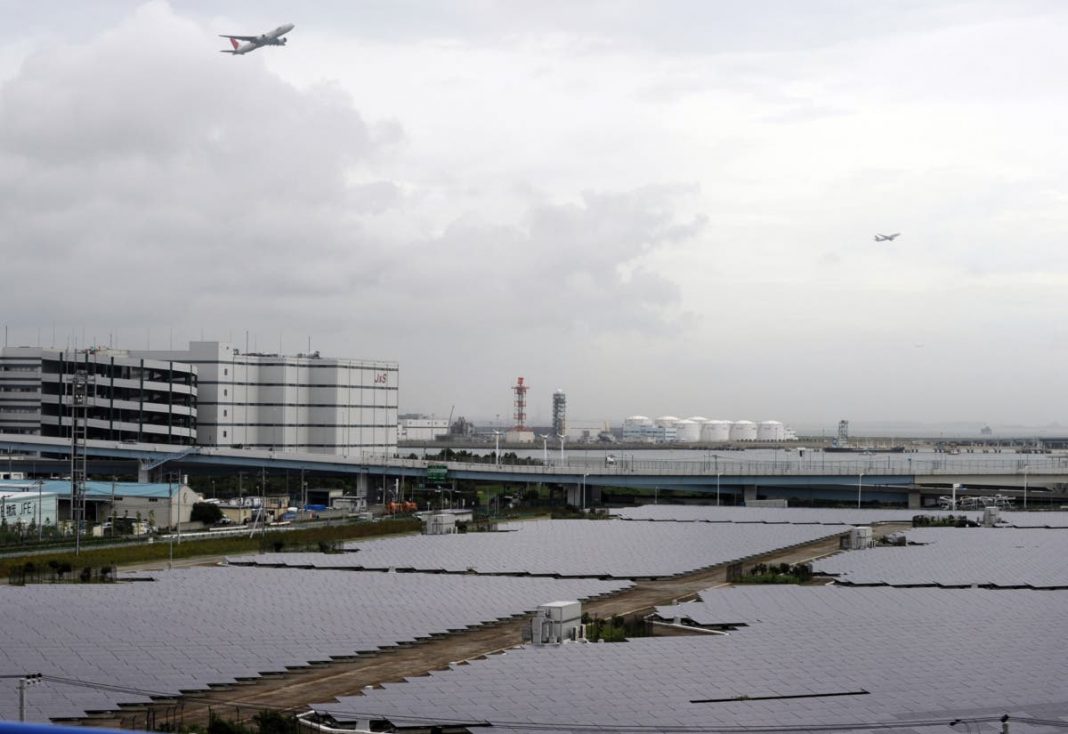Edmonton International Airport in Canada has announced this week that it plans to build the world’s largest airport-based solar panel farm. With more than 300,000 panels, it will turn the airport into a completely renewable entity and benefit the local community. So, why don’t more airports take advantage of their green space for solar power?

What role do airports play in climate change?
The carbon footprint of the aviation industry has been a topic of debate for many years. There have been various discussions about how airlines can reduce their CO2 emissions while maintaining growth, which sparked, among other things, the launch of CORSIA. Airlines have steadily been updating their fleets, investing in carbon offsetting, and looking into new technologies to fuel their aircraft. With all this going on, what role do airports have to play?
There have, of course, been many notable developments in airports when it comes to the environment. One example is the implementation of carbon-neutral taxis in Amsterdam’s Schiphol Airport for selected airlines to reduce their fossil fuel consumption before take-off. However, with emissions rising, it is becoming vital that everyone contributes where they can to prevent further global warming.

The world’s largest solar farm
One airport in Canada is taking on the challenge of boosting its environmental contribution. Edmonton International Airport announced on July 7th that it would be launching the world’s largest airport-based solar farm. With 340,000 solar panels across 627 acres, the airport predicts it will be able to offset 106,000 tonnes of CO2 annually. What’s more, it will create jobs boosting the local economy.
With such a tremendous contribution in terms of economic and environmental investment, it begs the question: why don’t more airports have solar panels?
There’s undoubtedly space. Much of the green areas around the runway on airport grounds seem to be unused. What’s stopping airports converting portions of their land into solar farms?

Is this why airports won’t invest in solar?
While implementing solar farms at airports may not be anyone’s initial first thought, on further reflection, it does seem viable. With so much grass and little use for it, solar panels could make efficient use of large amounts of land.
However, there is a reason why airports have so much land around them. Though to the untrained eye, they may seem wasted; there is purpose in having expanses of grass. For one, the grass is essential for managing noise pollution from aircraft. Firing up engines for take-off and landing can easily disturb those living nearby. It’s one line of reasoning that has impeded airport expansion plans in the past. With more grass, airports can mitigate noise pollution for those who live nearby.

Furthermore, the addition of grass makes it easier for pilots to see the runways upon approach in less than ideal conditions. Rather than having an all-grey area to survey when landing, the runway is more visible thanks to the contrast against the grass.
Other advantages of open grass spaces include:
- necessary clearance around the runway;
- balancing surface runoff;
- keeping air temperatures cooler to facilitate better aircraft lift.
CO2 absorption vs. mitigation
In the environmental argument, grass is crucial for the balance of CO2 in our atmosphere. It absorbs these resultant emissions from aircraft activity, contributing to cleaner air. It’s apparent that building on this land would interfere with natural climate solutions and could make airports more dangerous for aircraft activity.

That said, the advantage of solar farms is significant – and not only for the environment.
In 2018, Cochin International Airport in India made headlines by receiving the United Nations Earth Award for Entrepreneurial Vision. In 2015, it became the world’s first solar-powered airport. The project started in 2013 with a 100kW project that was soon scaled up. These days, Cochin International Airport produces 120,000 daily units of power. That means that it runs entirely off solar power and is now in a position where it feeds back to the national grid.
Not only has it been able to offset its energy and that of the surrounding area, but it’s also saved money. It no longer pays for electricity, which has significantly cut its overheads.

Should more airports have solar power?
Generating solar power for airports and their local areas certainly makes sense. Many across the world have jumped at the challenge, including in the US. Washington Dulles International Airport is in the process of implementing 1,200 acres of solar panels to create a fully functioning solar farm by 2023. It will be able to power 25,000 homes in the local area in the best-case scenario.
Likewise, Chattanooga Metropolitan Airport in Tennesse runs entirely on solar energy. It uses 10,000 solar panels across 12 acres to facilitate its energy generation. Again, Indianapolis International Airport has 76,000 solar panels across 151 acres creating more than 31 million kW-hours of electricity annually.

Therefore, solar power at airports is possible and is a proven strategy of energy generation. While there will be regulations for clearance around the runway, other green spaces around the airport could effectively be used as solar farms since they won’t drastically reduce the amount of grass for noise pollution. What’s more, airports can still create solar farms away from runways to give pilots the best visibility possible. Evidently, solar farms can still be safe and work around airport needs.
There’s just one catch.

Cost-effective solar power
Solar power does not come cheap, and that could be one of the hindering factors when it comes to more airports investing in it. It requires a substantial upfront cost that could take many years to earn back. In the case of investments that come from Federal Aviation Administration grants, it could take around 20 years to make back $5m of investment.
That said, anything worth investing in will not come cheap, but the benefits are worth it. In this case, for jobs, reduced overheads, and a cleaner world, solar-power could be an idea that more airports take up.
Do you think more airports should also double up as solar farms? Have your say in the comments.



